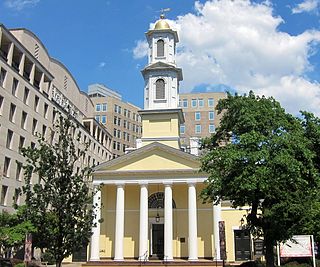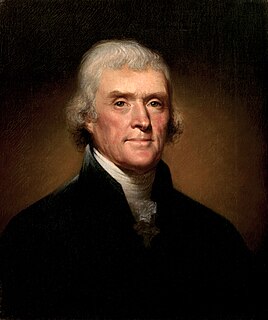Related Research Articles

The religious affiliations of presidents of the United States can affect their electability, shape their stances on policy matters and their visions of society and also how they want to lead it. Speculation of Thomas Jefferson, Abraham Lincoln, and William Howard Taft being atheists was reported during election campaigns, while others, such as Jimmy Carter, used faith as a defining aspect of their campaigns and tenure to hold the office. Almost all of the presidents can be characterized as Christian, at least by upbringing, though some were unaffiliated with any specific religious body. Protestants predominate, with Episcopalians and Presbyterians being the most prevalent. The United States has had one Catholic president. There have been four Nontrinitarian presidents. No president has openly identified as atheist.

Thomas Jefferson was an American statesman, diplomat, lawyer, architect, philosopher, and Founding Father who served as the third president of the United States from 1801 to 1809. He had previously served as the second vice president of the United States between 1797 and 1801. The principal author of the Declaration of Independence, Jefferson was a proponent of democracy, republicanism, and individual rights, motivating American colonists to break from the Kingdom of Great Britain and form a new nation; he produced formative documents and decisions at both the state and national level.
Sarah "Sally" Hemings was an enslaved woman of mixed race owned by President Thomas Jefferson. Multiple lines of evidence indicate that Jefferson had a long-term sexual relationship with Hemings, and historians now broadly agree that he was the father of her six children. Hemings was a half-sister of Jefferson's wife, Martha Jefferson. Four of Hemings's children survived into adulthood. Hemings died in Charlottesville, Virginia, in 1835.
Randolph Jefferson was the younger brother of Thomas Jefferson, the only male sibling to survive infancy. He was a planter and owner of the Snowden plantation that he inherited from his father. He served the local militia for about ten years, making Captain of the local militia in 1794. He also served during the Revolutionary War.

Martha Skelton Jefferson was the wife of Thomas Jefferson. She served as First Lady of Virginia during Thomas' term as Governor from 1779 to 1781, but did not serve as First Lady of the country because she died in 1782, 19 years before he became President.

Martha "Patsy" Randolph was the eldest daughter of Thomas Jefferson, the third President of the United States, and his wife, Martha Wayles Skelton Jefferson. She was born at Monticello, near Charlottesville, Virginia.

John Wayles Eppes was an American lawyer and politician. He represented Virginia in the U.S. House of Representatives and in the U.S. Senate (1817–1819), after serving in the Virginia House of Delegates (1801–1803). A member of the wealthy planter class, he was related through his mother to Martha Jefferson, the wife of Thomas Jefferson, with whom Eppes was close.
Jane Randolph Jefferson was the wife of Peter Jefferson and the mother of US president Thomas Jefferson. Born in the parish of Shadwell, near London, she was the daughter of Isham Randolph, a ship's captain and a planter. Born in London, Jefferson was proud of her heritage and brought customs of aristocracy to her family. Jefferson was revered within her family's household and positively influenced her son, Thomas Jefferson.
Virginia Randolph Cary was an American writer. She was the author of Letters on Female Character, Addressed to a Young Lady, on the Death of Her Mother (1828), an influential advice book.
Elizabeth "Betty" Hemings was an enslaved mixed-race woman in colonial Virginia. With her master, planter John Wayles, she had six children, including Sally Hemings. These children were three-quarters white, and, following the condition of their mother, they were enslaved from birth; they were half-siblings to Wayles's daughter, Martha Jefferson. After Wayles died, the Hemings family and some 120 other slaves were inherited, along with 11,000 acres and £4,000 debt, as part of his estate by his daughter Martha and her husband Thomas Jefferson.

The religious views of Thomas Jefferson diverged widely from the traditional Christianity of his era. Throughout his life, Jefferson was intensely interested in theology, religious studies, and morality. Jefferson was most comfortable with Deism, rational religion, Theistic rationalism, and Unitarianism. He was sympathetic to and in general agreement with the moral precepts of Christianity. He considered the teachings of Jesus as having "the most sublime and benevolent code of morals which has ever been offered to man," yet he held that the pure teachings of Jesus appeared to have been appropriated by some of Jesus' early followers, resulting in a Bible that contained both "diamonds" of wisdom and the "dung" of ancient political agendas.

Thomas Jefferson, the third president of the United States, owned more than 600 African-American slaves throughout his adult life. Jefferson freed two slaves while he lived, and seven more after his death. Jefferson consistently spoke out against the international slave trade, outlawed while he was President, while he privately advocated gradual emancipation and colonization of domestic slaves. Jefferson believed black people were inherently inferior to white people and thought it was best the two races remained segregated.
Harriet Hemings was born into slavery at Monticello, the home of Thomas Jefferson, third President of the United States, in the first year of his presidency. Most historians believe her father was Jefferson, who is now believed to have fathered, with his slave Sally Hemings, four children who survived to adulthood.
Portobago, on the south shore of Rappahannock River, is an unincorporated community in Caroline County, in the U.S. state of Virginia. Its name originates from the old village, probably belonging to the Nandtaughtacund Powhatans during the 17th century.
John Wayles was a planter, slave trader and lawyer in the Virginia Colony. He is historically best known as the father-in-law of Thomas Jefferson, the third President of the United States. Wayles was married three times, and these marriages produced eleven children; only five of them lived to adulthood. Wayles' relationship with Betty Hemings resulted in six additional children, including Sally Hemings, who was the mother of six children with Thomas Jefferson and half-sister of Martha Jefferson.

Thomas Jefferson, the third president of the United States, was involved in politics from his early adult years. This article covers his early life and career, through his writing the Declaration of Independence, participation in the American Revolutionary War, serving as governor of Virginia, and election and service as Vice-President to President John Adams.

This Bibliography of works on Thomas Jefferson is a comprehensive list of published works about Thomas Jefferson, the primary author of the Declaration of Independence and the third President of the United States. Biographical and political accounts for Jefferson now span across three centuries. Up until 1851, virtually all biographical accounts for Jefferson relied on general and common knowledge gained from official records and public writings and newspapers. It wasn't until Henry S. Randall, the first historian allowed to interview Jefferson's family, giving him access to family letters and records, did biographies of Jefferson take on a more intimate perspective. Randall wrote an 1858 three-volume biography which set the premise for many biographies that followed.

Edmund Bacon (1785–1866), was the business manager and primary overseer for 20 years for Thomas Jefferson, third President of the United States, at Monticello. Among some of his other business duties, Bacon supervised the daily chores and activities of farming and ranching at Monticello along with Jefferson's nail forge. His duties included supervising and providing supplies and other needs for Jefferson's slaves. When he retired, Bacon moved to Kentucky and was discovered by the author Rev. Hamilton Pierson, who made use of his memoirs and letters to write a book about Jefferson's personal life and character. The memoirs of Bacon's life at Monticello has given much insight into the daily activities there, as well as into Jefferson's life and personality.
![Ann Cary Randolph Morris birth/death: 1774-1837 VIAF[187502670] LCAuth[n97095815]](https://upload.wikimedia.org/wikipedia/commons/thumb/b/b4/History_of_Art_for_Beginners_Vol_3_Architecture_131.jpg/320px-History_of_Art_for_Beginners_Vol_3_Architecture_131.jpg)
Ann Cary Randolph Morris (1774–1837), whose nickname was Nancy, was the daughter of Thomas Mann Randolph Sr. and the wife of Gouverneur Morris. Two books have been written about her and the scandal she was embroiled in—Unwise Passions: A True Story of a Remarkable Woman - and the First Great Scandal of Eighteenth-Century America and Scandal at Bizarre: Rumor and Reputation in Jefferson's America—with Richard Randolph, her brother-in-law and distant cousin.

Peter Fossett was an enslaved laborer at Monticello, Thomas Jefferson's plantation, who after he attained his freedom in the mid-1800s, settled in Cincinnati where he established himself as a minister and caterer. He was a captain in the Black Brigade of Cincinnati during the Civil War. Fossett was an activist for education and prison reform. He was a conductor on the Underground Railroad. His remembrances, Once the slave of Thomas Jefferson, was published in 1898.
References
- 1 2 3 Edward Lloyd Lomax (1913). Genealogy of the Virginia Family of Lomax. Rand, McNally & Company. pp. 22–.
- 1 2 3 4 Susan Hill Lindley; Eleanor J. Stebner (2008). The Westminster Handbook to Women in American Religious History. Westminster John Knox Press. pp. 134–. ISBN 978-0-664-22454-7.
- 1 2 3 "Founders Online: Judith Lomax's Poem: "Monticello," [ca. August 1813]" . Retrieved 13 December 2016.
- 1 2 Joseph M. Flora; Lucinda Hardwick MacKethan (1 November 2001). The Companion to Southern Literature: Themes, Genres, Places, People, Movements, and Motifs. LSU Press. pp. 971–. ISBN 978-0-8071-2692-9.
- 1 2 3 4 Catherine A. Brekus (13 November 2009). The Religious History of American Women: Reimagining the Past. Univ of North Carolina Press. pp. 157–. ISBN 978-0-8078-6799-0.
- ↑ Kevin J. Hayes (19 May 2015). A History of Virginia Literature. Cambridge University Press. pp. 148–. ISBN 978-1-107-05777-7.
- ↑ David S. Shields (2007). American Poetry: The Seventeenth and Eighteenth Centuries . Library of America. ISBN 978-1-931082-90-7.
- ↑ Kevin J. Hayes (1 June 2012). The Road to Monticello: The Life and Mind of Thomas Jefferson. Oxford University Press. pp. 145–. ISBN 978-0-19-971908-2.
- ↑ Early American Poetry, 1610–1820: A List of Works in the New York Public Library. New York Public Library. 1917. pp. 32–.
- ↑ "Founders Online: Thomas Jefferson to John Adams, 22 August 1813" . Retrieved 13 December 2016.